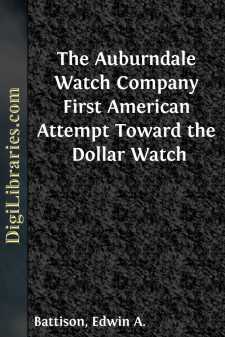Categories
- Antiques & Collectibles 13
- Architecture 36
- Art 48
- Bibles 22
- Biography & Autobiography 813
- Body, Mind & Spirit 142
- Business & Economics 28
- Children's Books 17
- Children's Fiction 14
- Computers 4
- Cooking 94
- Crafts & Hobbies 4
- Drama 346
- Education 46
- Family & Relationships 57
- Fiction 11829
- Games 19
- Gardening 17
- Health & Fitness 34
- History 1377
- House & Home 1
- Humor 147
- Juvenile Fiction 1873
- Juvenile Nonfiction 202
- Language Arts & Disciplines 88
- Law 16
- Literary Collections 686
- Literary Criticism 179
- Mathematics 13
- Medical 41
- Music 40
- Nature 179
- Non-Classifiable 1768
- Performing Arts 7
- Periodicals 1453
- Philosophy 64
- Photography 2
- Poetry 896
- Political Science 203
- Psychology 42
- Reference 154
- Religion 513
- Science 126
- Self-Help 84
- Social Science 81
- Sports & Recreation 34
- Study Aids 3
- Technology & Engineering 59
- Transportation 23
- Travel 463
- True Crime 29
The Auburndale Watch Company First American Attempt Toward the Dollar Watch
Categories:
Description:
Excerpt
he idea of a machine-made watch with interchangeable parts had been in the minds of many men for a long time. Several attempts had been made to translate this conception into a reality. Success crowned the efforts of those working near Boston, Massachusetts, in the 1850’s. The work done there formed the basis on which American watch making grew to such a point that by the 1870’s watches of domestic manufacture had captured nearly all the home market and were reaching out and capturing foreign markets as well. In spite of this great achievement there remained a large untapped potential market for a watch which would combine the virtues of close time keeping and a lower selling price. Only a radical departure in design could achieve this. Rivalry between the several existing companies had already produced an irreducible minimum price on watches of conventional design.
The great obstacle to close rate in a modestly priced watch is the balance wheel. This wheel requires careful adjustment for temperature error and for poise. Of these two disturbing factors poise is the most annoying to the owner because lack of it makes the watch a very erratic timekeeper. A watch in which the parts are not poised is subject to a different rate for every position it is placed in. This position error, as it is called, can and often does cause a most erratic and unpredictable rate. Abraham-Louis Breguet, the celebrated Swiss-French horologist of Paris is credited with the invention, in 1801, of his tourbillon, a clever way to circumvent this error.
Figure 1.—Breguet’S Tourbillon. At C is shown the carriage which revolves with pinion B carrying the escapement and balance around the stationary wheel G. (After G. A. Baillie, Watches, their history, decoration, and mechanism, London, Methuen, n.d.)
His solution was to mount the escapement in a frame or “chariot” which revolved, usually once a minute, so that with each revolution all possible positions were passed through (fig. ). This gave the watch an average rate which was constant except for variations within the period of revolution of the chariot. Only a very skillful workman could, however, work with the delicacy necessary to produce such a mechanism. The result was that few were made and these were so expensive that it continued to be more practical to poise the parts in a conventional movement. The idea of revolving the entire train of a watch, including the escapement, seems to have evolved surprisingly slowly from Breguet’s basic invention of the revolving escapement. In constructing a watch wherein the entire train revolves, no such delicate or precise workmanship is required as in the tourbillon. Due to the longer train of gears involved the period of revolution is much slower. Position errors average out as certainly if not as frequently. In Bonniksen’s “Karrusel” watch of 1893 the duration of a cycle is 52.5 minutes while in the Auburndale Rotary which we are about to discuss the period of each revolution is 2-/ hours....



